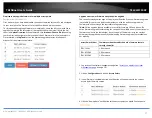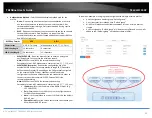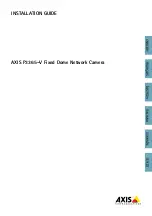
© Copyright 2017 TRENDnet. All Rights Reserved.
TRENDnet User’s Guide
TEW-WLC100P
31
Roaming – Select which roaming protocols to enable for the wireless profile.
o
802.11k – This protocol enables the exchange of messages between
APs and client devices which includes utilization and signal strength
information of neighboring APs in the same wireless network. This
protocol can assist supported client devices in better roaming
decisions when transitioning between multiple APs in the same
wireless network. Client devices must support 802.11k in order to use
this feature but it can be safely enabled and functioning whether or
not client devices support this standard.
o
802.11r – This protocol allows client devices to pre-authenticate with
neighboring APs to significantly reduce the transition time or eliminate
the need for re-authentication during transition from one AP to
another. Client devices must support 802.11r in order to use this
feature and should not be enabled unless client devices support this
standard.
o
OKC (Opportunistic Key Caching) – This protocol functions as a non-
standard version of 802.11r in allowing client devices to pre-
authenticate with neighboring APs. This protocol operates
independently on the controller and APs and does require client
devices to support any specific pre-authentication roaming standards.
This setting is recommended for the highest compatibility in order for
all client devices to benefit fast roaming transition across your wireless
network.
VLAN – Enable this option to assign a specific 802.1q VLAN tag or ID to the SSID
or wireless profile. By assigning a specific VLAN tag or ID, client devices that
connect to the profile, will be placed in the specified VLAN.
Note: 802.1q VLAN should be configured on your switch router and network
infrastructure to support use this feature.
RSSI Threshold – Enable this option set a signal strength limit on wireless client
devices when the AP will force the client to disconnect.
In a wireless roaming network with multiple access points, this feature can
assist by forcing the disconnection of the wireless client device before signal
strength and connectivity to the AP are too low to sustain enough bandwidth
for Internet streaming applications. This will force the wireless client device to
connect to another AP with a stronger signal and connection rate relative to it’s
new location. It is the nature of wireless client devices to maintain connectivity
to the currently connected AP as long as the signal can still be discovered.
In the example diagram, you can see that the further away the client device is
from the AP, the lower signal strength. (-30 RSSI is a higher strength value
relative to the AP compared to -90 RSSI). The client device at -90 RSSI is closer
to the next AP but without the forced disconnection from the AP on the left,
without the RSSI threshold function, the client device would remain connected
to the much further AP on the left than stronger signal AP on the right. Forcing
a disconnect from the originally connected AP on the right would force the
client to connect to the much higher signal strength AP on the right providing
better connectivity during the transition between physical locations.
Summary of Contents for TEW-WLC100P
Page 1: ...TRENDnet User s Guide Cover Page ...
Page 57: ......
















































